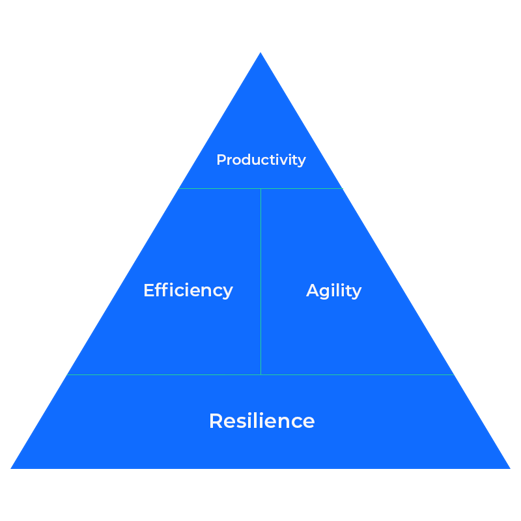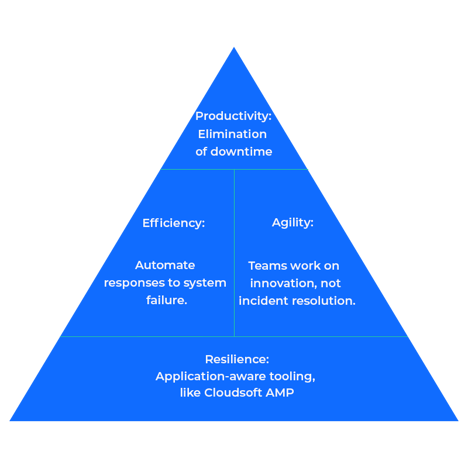Why hyperautomation alone won't solve your resilience problem.
/4.png?width=200&name=4.png)
According to Gartner, by 2024 over 70% of large global enterprises will have over 70 concurrent hyperautomation initiatives. The COVID-19 pandemic has accelerated many organisations’ move to digital-by-default processes and has revealed the stresses and strains these moves place on the resiliency of systems. In addition, the complexity of these initiatives puts their stability at risk; delivering well-governed, operationally resilient systems may require a fresh approach to the resilience problem.
To deliver business results, enterprises’ focus should be on Resilience, Efficiency, Agility, Productivity (REAP). Hyperautomation technologies help to deliver efficiency through the end-to-end orchestration of digital, business and IT processes and should be deployed cross-functionally to maximise agility and productivity. However, it should not be assumed that hyperautomation delivers resiliency-by-default - that is the role of the applications composing the hyperautomated process.
What is Hyperautomation?
First, let’s take a step back and define our terms. The term “hyperautomation” appeared in October of 2019, taking the top spot on Gartner’s Top 10 Strategic Technology Trends for 2020 list. Hyperautomation is also sometimes referred to as “digital process automation,” while IDC and others use “intelligent process automation.” However, hyperautomation isn’t just another technology trend. It describes a real shift in the way that humans and technologies interact and is central to Gartner’s definition:
“Automation uses technology to automate tasks that once required humans'' whereas hyperautomation relates the “application of advanced technologies like AI and ML to increasingly automate processes and augment humans”.
In addition, hyperautomation refers to the sophistication of the automation. Human thought cannot (yet) be replaced by a single tool, so hyperautomation doesn’t just automate a task, it automates a process across multiple tools with multiple potential outcomes or decision points, often using AI.
Put simply, the digital-by-default world is leading to a shift away from the automation of defined/described tasks by humans. Hyperautomation is different because it seeks to introduce artificial intelligence alongside human intelligence, to not only execute tasks throughout a complex process across multiple platforms, but to solve problems that are not yet identified by the people overseeing the processes - you have to tell a robot what to do and when to do it, but with hyperautomation the machine can learn what needs to be done and when.
What does hyperautomation mean for Technology Leaders?
Hyperautomation is not just another project to be ticked-off or buzzword for conference agendas, but a principle to be embraced. Gartner identifies hyperautomation principles as being transformative not just to business technologies but to the humans who design, deliver and use them. As such, there are two key takeaways for Technology leaders:
- Look beyond technical debt to process debt.
There has been an overwhelming focus on the upgrading of legacy systems and applications, but hyperautomation requires this focus to shift to not just upgrading but rewriting the business processes they enable too. This unlocks efficiencies and enables changes to the structure of technology teams.
- Adopt a multidisciplinary approach to technology projects.
Fusion Teams have the ability to adopt the customer-centric, agile, product management focus of digitally native organisations. Fusion Teams are organised around business outcomes, rather than in technology silos, to combine scale with agility and responsiveness to stakeholder needs.
The ultimate goal may be to enable the reinvention of business operations, however hyperautomation also comes with risks - especially for operational resilience.
The Resilience problem
IT Resilience is the foundation upon which you can deliver business goals. Without resilient systems, organisations can’t function. In the context of hyperautomation, often deployed to enable productivity through efficiency and agility, it is critically important due to the interconnected systems, platforms and tools it operates across. Fig.1 REAP - Resilience, Efficiency, Agility, Productivity
Fig.1 REAP - Resilience, Efficiency, Agility, Productivity
If you have multiple hyperautomation initiatives running concurrently, across multiple applications and in multiple locations , your automations are likely to be making millions of requests per second, powering live decision making on, for example, a trading floor. What happens if your hyperautomated environment fails because a core component missed a pivotal upgrade? Every second of downtime could represent millions of lost dollars in transactions, never mind the cost of unpicking the mess once systems are back up and running.
An application-centric approach to resilient hyperautomation
Much like the cross-functional nature of Fusion teams, rooting operational resilience in the applications used for these hyperautomated business processes, rather than the infrastructure the applications inhabit, enables the automation of resilience across technical silos and has the knock-on effect of fulfilling REAP criteria up the chain.
As outlined in our Application Resilience Maturity Model and eBook, the pinnacle of application resilience is modelling your applications. This enables you to automate the testing and deployment of reusable recovery and update patterns to support the application wherever it runs.
Cloudsoft AMP enables this application-centric approach to resilience by providing a rich, live model of applications to manage the necessary multiplicity of monitoring and automation systems.

Fig.2 REAP - Resilience, Efficiency, Agility, Productivity
Eliminate the cost of downtime
Manual recovery is time-consuming and costly. When an application fails, your team may need to interrogate multiple separate inventory systems before they can even begin to diagnose the problem and restore service.
When AMP detects an issue, it automatically deploys the recovery pattern to resolve it, meaning that system failure is not only much less likely to occur but in the event it does, occurs for a much shorter period of time. AMP can support applications to exceed “five-nines”, or 99.999% availability. This equates to less than 5 minutes of downtime per year.
Find out more about resilience in our Continuous Resilience Resource Center or book a conversation with one our Solution Architects to find out how AMP can enable the resilience you need to drive value from hyperautomation.
Sources
Gartner, Predicts 2021: Accelerate Results Beyond RPA to Hyperautomation, Stephanie Stoudt-Hansen, Frances Karamouzis, Melanie Alexander, Laurie Shotton, Nicole Sturgill, Rajesh Kandaswamy (December 2020)
CSO Online: EU's DORA regulation explained: New risk management requirements for financial firms, Dan Swinhoe
